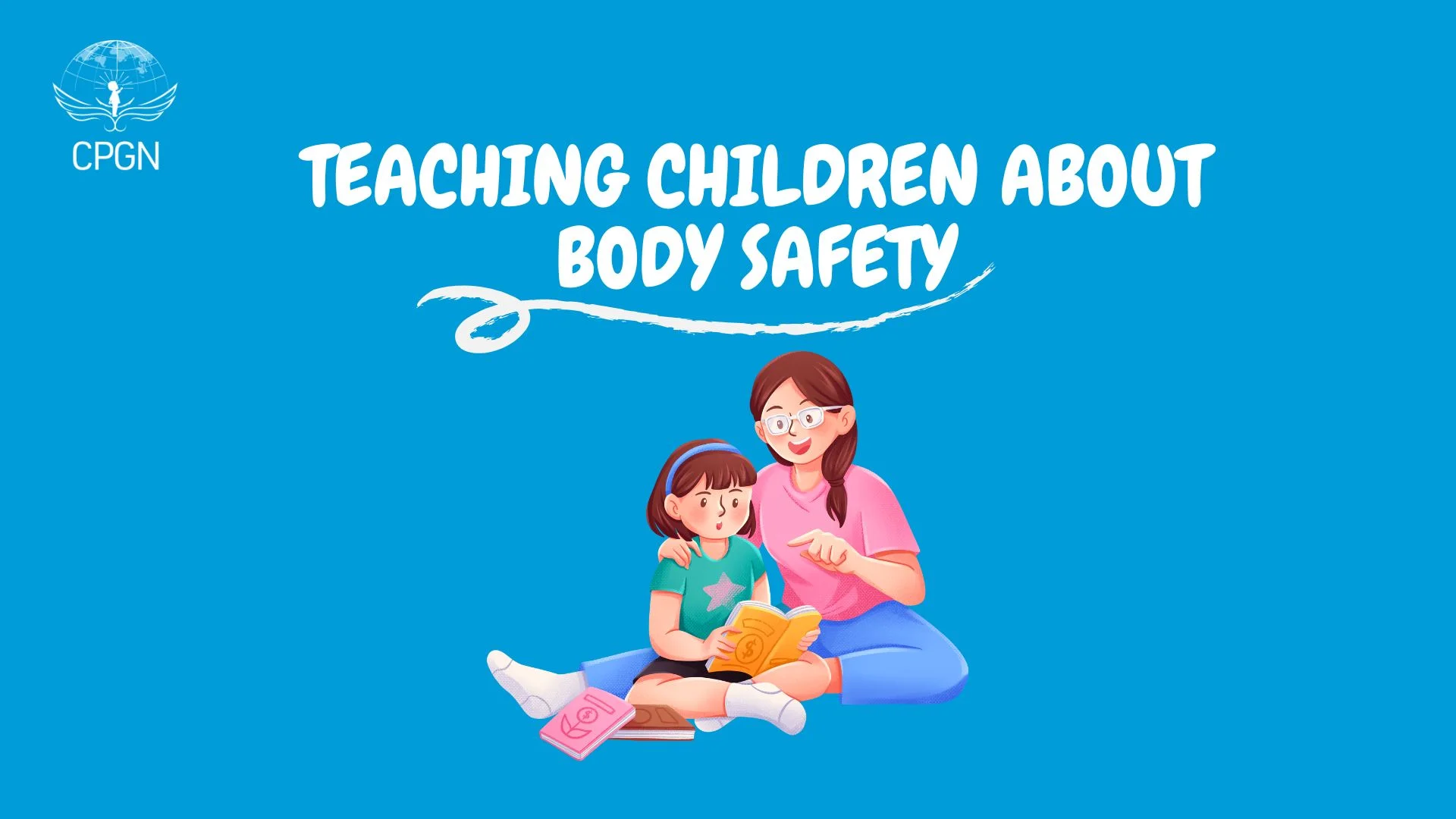Teaching Children About Body Safety
Learn CPGN’s recommended steps to educate children on body safety, private parts, and consent while fostering open communication and confidence.

Why is Body Safety Important? How to Talk to Young Children About Body Safety
Body safety for kids is a fundamental concept that helps children understand their right to personal space and protection from harm. Teaching children about body safety rules for kids empowers them to identify unsafe situations and act accordingly. It also equips them with the knowledge of body boundaries, which is essential for building healthy relationships and self-awareness.
Unfortunately, the statistics are troubling, with 1 in 5 girls and 1 in 20 boys experiencing some form of sexual abuse before the age of 18. By addressing this topic early, child advocacy organizations aim to reduce these alarming numbers and create safer environments for children. Body safety education is a powerful tool in preventing abuse and ensuring that children are aware of how to protect themselves from harm.

1. Teach Children About Their Bodies
The first step in teaching body safety for kids is ensuring they understand the correct names for their body parts. Teaching children the proper names for private parts not only fosters open communication but also helps them to feel comfortable discussing sensitive topics. Using the right terminology ensures that children have the vocabulary they need to talk about inappropriate situations.
Introducing these concepts early helps children recognize the boundaries of their bodies. It’s also important to explain that the areas covered by a swimsuit are private and should not be touched by others. This helps children understand their personal space and gives them the tools to speak out if anyone crosses that line.
2. Discuss Appropriate Touch
When talking about body safety for kids, it’s crucial to teach the difference between safe, unsafe, and unwanted touch. Safe touches, like hugs or holding hands, are those that make children feel loved and respected. Unsafe touches, such as hitting or kicking, hurt children physically or emotionally and should never be allowed.
Unwanted touches are those that make a child feel uncomfortable, even if they aren’t physically painful. Children need to understand that they have the right to say no to unwanted touch, regardless of who it is from. This right teaches them that they are in control of their own bodies and can set boundaries with anyone.
3. Teach Children About Personal Boundaries
Teaching children about personal boundaries is one of the most important aspects of body safety. Children need to understand that they have the right to protect their personal space. This means that they can say no to any touch or action that makes them uncomfortable, and they should feel empowered to do so.
It’s also essential to explain that personal boundaries apply to everyone, not just strangers. Even trusted family members or friends should respect a child’s personal space. Reinforcing the idea that it’s okay to establish boundaries and say no helps children develop a sense of autonomy over their bodies.
4. Encourage Open Communication
Creating an environment where children feel comfortable talking about body safety is essential. Encourage children to ask questions and discuss any concerns they might have. By ensuring that they know they can talk openly about their feelings, you create a safe space for them to share if something feels wrong.
Use simple, clear language and reassure children that they won’t get in trouble for speaking up. Teaching children the “No, Go, Tell” method empowers them to act in situations where they feel unsafe. They should know that they can say no, run to safety, and tell a trusted adult without fear of repercussions.
5. Practice Scenarios
Role-playing is a useful tool for teaching body safety. By practicing different scenarios, children can rehearse how to react if they are in an uncomfortable or unsafe situation. You can act out situations where a child may need to say “no” or “go” to a safe adult, helping them feel confident in their response.
Repetition is key, and by practicing these scenarios regularly, children will become more comfortable with the idea of setting boundaries. This will help them to feel more prepared if they ever find themselves in a situation where they need to assert their rights and speak out against inappropriate behavior.
6. Empower Your Child
Empowering your child to take control of their body safety is one of the most important aspects of body safety education. When children feel confident in their ability to protect themselves, they are more likely to set and enforce personal boundaries. This also boosts their self-esteem and gives them a sense of security.
Let your child know that they have the right to say no to any touch that makes them uncomfortable, and that they are in charge of their own body. Reinforce that you are always there to support them, and encourage them to speak out if they feel that their boundaries are being violated. This sense of empowerment will stay with them as they grow older.
How CPGN Supports Body Safety Education

CPGN (Child Protection and Global Network) plays a crucial role in supporting body safety education by providing resources and training for parents, caregivers, and educators. Their programs aim to raise awareness about child abuse prevention and promote safe practices for teaching children about body boundaries and self-protection.
Through workshops and outreach, CPGN helps communities understand the importance of body safety rules for kids. By partnering with organizations like CPGN, parents and guardians are better equipped to educate children about body safety and create environments where children feel empowered to speak up if something feels wrong.
FAQs
Body safety rules are guidelines designed to help children understand their rights regarding personal space and protection from inappropriate touch. These rules teach children about their body boundaries, appropriate touch, and how to recognize unsafe situations. Key body safety rules include teaching children to say no to unwanted touch, understanding that certain areas of their body are private, and knowing that they have the right to speak up if something makes them uncomfortable.
Teaching body safety to children involves introducing concepts like personal boundaries, appropriate and inappropriate touch, and open communication. Start by using age-appropriate language, and teach children the correct names for body parts. Discuss the difference between safe, unsafe, and unwanted touch, and empower children to say no and tell a trusted adult if they feel uncomfortable. Repeatedly practicing scenarios helps reinforce their understanding and confidence in setting boundaries.
Talking about body safety with kids should be done in an open, non-judgmental, and age-appropriate manner. Begin by discussing body parts, emphasizing that some parts are private and should not be touched by others. Teach them the difference between safe and unsafe touches. Encourage them to ask questions and let them know they can talk to you about anything that makes them feel uncomfortable. Use simple phrases like “No, Go, Tell” to help children respond in unsafe situations.
Body safety refers to teaching children how to protect their personal space and body from inappropriate or harmful touch. It includes educating children about their body autonomy, private parts, and the importance of setting personal boundaries. Body safety also involves creating an environment where children feel comfortable talking about their feelings and any uncomfortable situations they may experience.
Body safety for kids is the practice of teaching children how to recognize and protect themselves from inappropriate behavior, such as unwanted touch or sexual abuse. It involves educating them about the importance of personal boundaries, appropriate touch, and how to communicate when something feels wrong. Body safety education helps children understand their rights and empowers them to protect themselves from harm.
Body safety education involves teaching children and adults about the importance of respecting personal boundaries, understanding consent, and recognizing inappropriate or harmful behavior. It includes topics like private body parts, appropriate touch, and how to handle situations involving unwanted touch. Body safety education is essential in preventing abuse and helping children develop a healthy sense of body autonomy.
The body safety cycle is the ongoing process of teaching children to recognize unsafe situations, set personal boundaries, and seek help from trusted adults.
It reinforces awareness, communication, and action to keep their bodies and feelings protected.
Mark Schwartz
Our goal is to ensure the safety and protection of every child until it is achieved. Our goal is to support communities in protecting the future of children and promoting their welfare.
Quick Links

Our goal is to ensure the safety and protection of every child until it is achieved. Our goal is to support communities in protecting the future of children and promoting their welfare.
Quick Links
Copyright © 2025 CPGN. All rights reserved by Majnate LLP | Privacy Policy | Terms and Conditions
